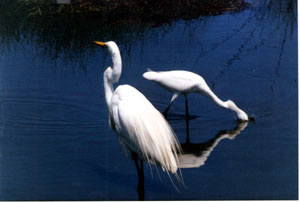|
Tar Heel Travels
Birding on the Outer Banks
A novice sees the beauty of a beach from the
viewpoint of a white ibis
 By
Bill F. Hensley By
Bill F. Hensley
Over Friday night coffee and dessert at
the impressive First Colony Inn in Nags Head, our guides — Eric and Celia Dean
of Goldsboro — showed slides of the numerous birds we would probably see
during the weekend. An early dropout of the Avian Identification School, I can
tell the difference between a blue jay and a buzzard, but I wouldn’t know a
yellow-bellied sapsucker if it lit on my shoulder. Here I was in the midst of
some enthusiastic folks who took their birdwatching seriously. I was in over my
head and knew it.
I decided early not to tell anyone that I was an avid hunter of things that fly,
such as quail, doves, pheasants and ducks. For much of my adult life, the birds
I sought were found, flushed and retrieved by a hard working pointer or setter.
There was no use in being persona non grata in a society whose numbers outrank
golfers and anglers.
It was mid-January, and it was cold and windy. Why do you birdwatch in the
winter, I wondered. “Because the tourists have gone home, the beaches are
deserted and thousands of birds are in residence,” explained Eric Dean, a
knowledgeable, friendly and enthusiastic businessman whose hobby is birding. It
sounded plausible to me.
When the 16 of us hit the beach at 7:30 the next morning, my wife and I looked
— except for the boots — as if we were going skiing, wearing everything we
owned that was appropriate for the winter sport. The wind off the ocean was
cruel, but the birds — gulls, terns and sanderlings — didn’t seem to mind.
After a half hour, we retired to the historic inn for a hot breakfast before
caravaning to the Pea Island National Wildlife Refuge.
Our first stop was at the Bodie Island Lighthouse where, with binoculars in
hand, we saw meadowlarks, flickers, snowy egrets, tundra swans and a white ibis.
After listening to participants call out the various names of what we were
seeing, I realized I had a long way to go before being any good at this watching
business.
At the Oregon Inlet Fishing Center, our guides pointed out boat-tailed grackles
and several species of warblers, ducks and geese. Now I was even more confused
but enjoying every minute of this new experience.
As we moved on to the Old Coast Guard station at the foot of the Bonner Bridge,
there were mergansers, plovers and cormorants to learn about. Even louder than
the swirling wind was the rustling of pages in bird books as the watchers turned
hurriedly to descriptive passages.
There were countless snow geese at the Pea Island Visitor Center as well as
avocets, pelicans and grackles. As we walked a trail toward the marshlands, we
were surrounded by a sky full of birds of every color and description that were
constantly landing and taking off from the many lakes and ponds, going about the
business of finding food.
A mile or two south of the famed Cape Hatteras lighthouse, we encountered a
beach full of gulls and two fresh water lakes that were covered with ducks.
Yellow-rumped warblers were everywhere.
On Sunday, the group again visited the beach before breakfast and then drove
back to Pea Island where we found a few oystercatchers and forster terns. There
were so many snow geese covering the dunes that, at first glance, it looked like
there had been an overnight snowfall. By noon, our guides checked off a list of
72 species we had seen out of nearly 400 varieties that are known to inhabit the
area.
In looking back, numerous highlights will linger in our memory: a pair of
big-eyed horned owls roosting in the tall trees behind a family cemetery in
Rodanthe; hundreds of large gulls taking off at one time and brightening the
clear blue sky with a black and white background that matched the lighthouse;
colorful bufflehead ducks diving into the freezing waters of the Pamlico Sound;
a single white ibis that starkly contrasted with the brown marsh grass; a lonely
peregrine falcon resting in an abandoned osprey nest casually surveying what
might be his evening meal; and the half-dozen black crowned night herons
comfortably roosting in the green trees overlooking the sound.
The rarest specie we saw was a dickcissl, a small sparrow-like bird with a
bright yellow breast, that was spotted in the bushes on the spacious grounds of
the First Colony Inn. More at home in the Midwest, the bird obviously was far
away from its natural habit and its migratory path.
The four birding trips that are held in conjunction with the stately inn are
sponsored by the North Carolina Nature Conservancy and are usually held in
October, November, December and January. The package cost is $380 for two, which
includes two nights accommodations, breakfast each day, one dinner, the guided
field trips, and the Friday evening talk with coffee and dessert. There is a
limit of 22 person for each outing, so it’s not too early to think ahead. For
more information, call the First Colony Inn at 800-368-9390 or visit www.firstcolonyinn.com.
Return to magazine
index
|